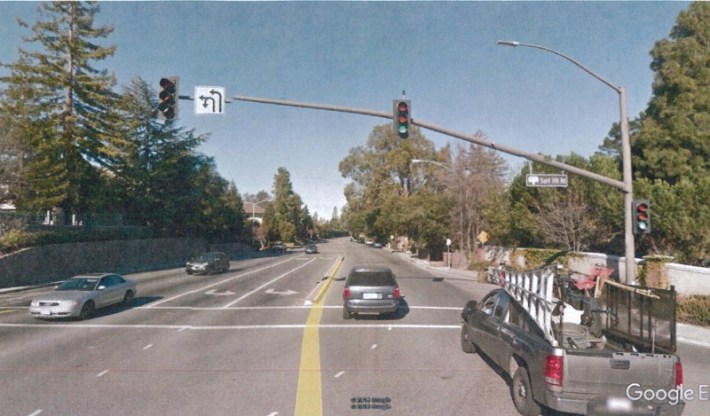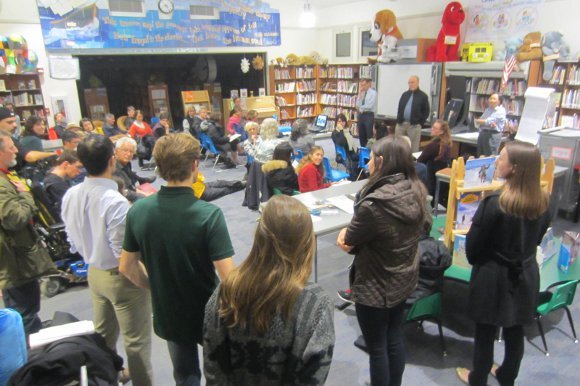Going by the results of a public meeting at Oak Knoll Elementary School in Menlo Park last Monday, San Mateo County traffic engineers have no options left to correct a dangerous five-lane stretch of Santa Cruz Avenue that runs from San Hill Road to Alameda de las Pulgas.
“I'm one of the cyclists that has been hit on this road and it was a very traumatic experience,” said a young woman at the meeting. “And it was also a traumatic experience for the driver.”
Not that they haven't proposed solutions, sort of. It's just that even the weak ones can't get traction. The latest: engineers had proposed restricting on-street parking to "provide a safer space for bicycling." The County's proposal would apply from Sand Hill Road to Alameda de las Pulgas on weekdays from 8-6 p.m., which would "provide additional riding space for cyclists," who would be expected to ride in the empty parking lane (it should be noted, with no planned striping or signage to tell them this).
That's only in the northbound direction. Heading southbound, the parking restrictions wouldn't do anything to improve safety, since there's currently no parking on that side of the street anyway--and no dedicated space for bicycling either.
But after blow back at the community meeting in Menlo Park, even the parking restriction proposal is off the table. Neighbors insisted that the parking spaces were critical and that removing them would not really address the safety hazards resulting from the street's design.
Resident Kirby Wilkins explained that multiple medical care professionals need to be able to park on the street to care for his son, who uses a wheelchair. “We have a handicapped van that comes in and out all the time during the day. Parking on that street is absolutely essential for us,” he said. The area is not well-served by transit and is located about two miles uphill from downtown Menlo Park, making it difficult for many to reach by bicycle or on foot.
County staff agreed to reconsider other options to improve traffic safety, such as removing traffic lanes--although they had concluded in a 2012 traffic analysis that even removing one northbound lane would “push the [Sand Hill Road] intersection into even more severe congested gridlock conditions.” That analysis recommended against any lane removals or changes to the street's design, although it concluded that removing one southbound lane “may be a viable option.”
So there's some hope.
Meanwhile, “there are 26 spots altogether. It's reasonably well-used but it's not at capacity,” said San Mateo County Public Works Deputy Director Joe LoCoco at last Monday's meeting. This segment of Santa Cruz Avenue lies between Palo Alto and Menlo Park but is not incorporated into either, so any changes to the street's design must be approved by the County.

The 1,500-foot long segment of Santa Cruz Avenue, with two traffic lanes in each direction and a center turn lane, represents a major gap in what is otherwise an excellent north-south regional bicycling route along Junipero Serra Boulevard and Alameda de las Pulgas.
Meanwhile, “The only way to ride that with the least bit of safety is to get in the middle of the lane... cars will squeeze by you, and I've had my handlebars hit,” said another neighbor at the meeting. Residents complained that high traffic speeds create a safety hazard for everyone using the street, and are the result of widening the roadway over 40 years ago.
“We would love to have the slowest speeds possible, but we need to be able to justify them by the standards that have been set by the state,” said LoCoco, referring to the 85th percentile rule used to set speed limits.
While San Mateo County staff are hesitant to remove traffic lanes, bottom line is that's what it will take to reduce speeds and make the area safer. The street also needs real, protected bike lanes--not just some vague "additional riding space." And if the state is really getting in the way, then the county needs to take some chances, get waivers, call Sacramento, work with the neighbors, scream and shout if they have to, and do what is necessary to make the road safe.
Staff engineers, instead, agreed to cancel the parking restriction proposal, which was scheduled to be heard by the Board of Supervisors later this month.





